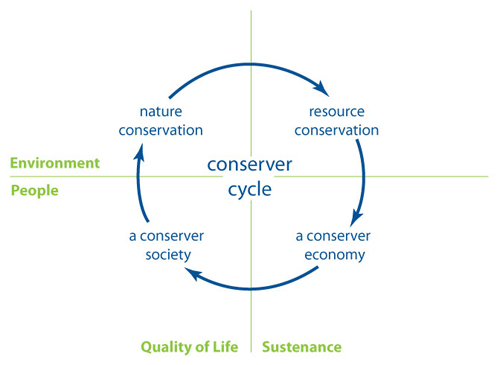From strategies to action
In a word, we are looking for commitment. A conservation strategy should cover all the conservation issues within your jurisdiction, and the steps you are taking to address them.
A conservation strategy should say “these are the issues that we face, and this is what we are going to do about them.” The best strategies are ones where the solutions wholly integrate environmental, economic, and social goals. Through conservation we can protect the natural environment; build a stronger, more resilient economy; and strengthen our communities and individual quality of life.
Step 1. Scan it.
A complete conservation strategy will cover nature, the economy, and society. In particular, these are the issues that should be covered:

1. Nature Conservation
- natural areas
- endangered species
- pollution prevention
2. Resource Conservation and a Green Economy
- water
- energy
- minerals and aggregates
- forests
- game species
- food species
- farmland
3. A Conserver Society
- a healthy conserver lifestyle
- complete communities
- local food
- strong local economies
- transportation alternatives
Step 2. Scope it.
If you cannot address all the issues at this time (there may be too many, or you may not have the resources), then focus on your priorities. Your constituents/customers will want to know that you are taking action on the issues that matter to them the most.
1. Start with the Vision.
The world over, we share a similar vision of a well-being and community, and that’s what makes the vision so important. It unites us in common values and aspirations.
2. Identify the Major Challenges.
On one level, we all face a similar challenge of creating sustainability out of uncertainty, but the specific challenges vary from region to region. These challenges include:
- Climate change (extreme weather, heat, drought)
- Resource scarcity (e.g. water, energy, food, land, minerals)
- Ecosystem integrity (pollution, extinction, overdevelopment)
- Economic uncertainty (employment, local economy)
Understand the links and look for interconnections and common causes. Embrace complexity before you propose simple solutions.
3. What do people want?
Read the pulse of your constituency. What are the top concerns: fiscal responsibility, job creation, transit, health care, community development, improved infrastructure? Look for solutions that reflect a convergence of economic, social and environmental goals.
4. Find the sweet spot.
We call conservation is the art of living lightly. It is an art, in that the trick lies in finding solutions that improve our lives, be it through a better quality of life, saving money, stronger communities and local employment, or the ability to live in accordance with our values.
Look for solutions that people can live with.
5. Empower change. Regulation and economic instruments are often necessary, but direct intervention is a big stick and is generally reserved for major initiatives. A good plan will complement the sticks with carrots to provide incentives for voluntary change.
The most important function of power is to empower others.
Step 3. Act.
Your strategy should cover three types of activities: internal, external and community. Think of it as “me, you, and we.”
1. The internal actions are those you can do yourself.
2. The external activities are how you interact with others (policies, programs, products, services etc.)
3. The community activities are how you help others within your community (your neighbourhood or your community of peers).

A Common Approach
A conservation strategy can be done by governments (federal, provincial, and municipal), by businesses and business associations, and by organizations or networks. In each case, the strategy should scope the issues, identify goals, list what you will do, and show how you can help others.
See also…
- What’s in a name? – the common links between different strategies and plans.
- Our scorecard for reviewing Canada’s strategies – an idea we are working on.